In this article, Snehasish CHINARA (ESSEC Business School, Grande Ecole Program – Master in Management, 2022-2024) explains the evolution of the most popular memecoin, Dogecoin.

Historical context and background
Dogecoin, a cryptocurrency that started as a joke, quickly evolved into a significant player in the world of digital assets. Created in December 2013 by software engineers Billy Markus and Jackson Palmer, Dogecoin was initially intended to satirize the hype surrounding cryptocurrencies at the time. The coin’s logo features the Shiba Inu dog from the “Doge” meme, which was immensely popular on the internet during that period. Despite its humorous origins, Dogecoin gained traction due to its welcoming and inclusive community, as well as its low transaction fees and fast confirmation times.
The early days of Dogecoin saw rapid adoption and a vibrant online community rallying around the coin. It gained attention for its philanthropic efforts, including fundraising campaigns to sponsor charity events and support causes such as building water wells in developing countries and sponsoring Olympic athletes. These initiatives helped distinguish Dogecoin from other cryptocurrencies and fostered a sense of community among its users.
Over time, Dogecoin’s popularity continued to grow, fueled in part by endorsements from notable figures such as Elon Musk, who frequently tweeted about the coin, further amplifying its visibility. Despite facing occasional security issues and challenges, Dogecoin has persevered, becoming one of the most recognized and traded cryptocurrencies in the market. Its unique blend of humor, community spirit, and accessibility has endeared it to a wide range of users, making it a significant player in the ever-expanding crypto landscape.
Doge Coin Logo

Source: Yahoo! Finance.
Figure 1. Key Dates in Doge Coin History
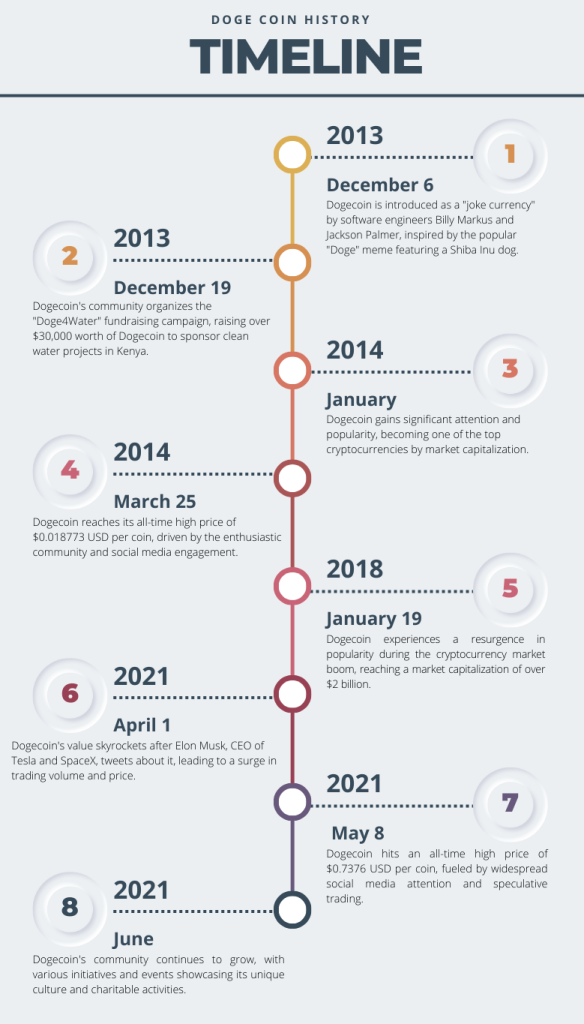
Source: Yahoo! Finance .
Key features
Decentralization
Like most cryptocurrencies, Dogecoin operates on a decentralized network, meaning it is not controlled by any single entity or organization. Transactions are recorded on a public ledger known as the blockchain, which is maintained by a network of nodes.
Scrypt Algorithm
Dogecoin uses the Scrypt algorithm for its proof-of-work consensus mechanism, which is less energy-intensive compared to Bitcoin’s SHA-256 algorithm. This allows for greater accessibility to mining for individuals with standard computer hardware.
Fast Transactions
Dogecoin boasts relatively fast transaction times, with blocks being mined approximately every minute. This makes it suitable for quick and efficient transfers of value.
Low Transaction Fees
Transaction fees on the Dogecoin network are typically minimal, making it cost-effective for transferring even small amounts of value.
Meme Culture
Dogecoin’s branding and marketing heavily leverage internet meme culture, particularly the “Doge” meme featuring the Shiba Inu dog. This playful and approachable branding sets Dogecoin apart from other cryptocurrencies and contributes to its widespread appeal.
Use cases
Tipping
Dogecoin gained popularity early on for its use as a tipping currency on social media platforms like Reddit and Twitter. Users can easily send small amounts of Dogecoin to content creators or other users as a form of appreciation.
Charitable Donations
The Dogecoin community has a history of supporting charitable causes and disaster relief efforts. Dogecoin has been used to raise funds for various initiatives, including sponsoring athletes, funding clean water projects, and aiding during natural disasters.
E-commerce
Some online merchants and retailers accept Dogecoin as a form of payment for goods and services. This includes businesses ranging from small independent shops to larger e-commerce platforms.
Micropayments
Dogecoin’s low transaction fees and fast confirmation times make it suitable for micropayments, allowing users to easily transfer small amounts of value online.
Community Engagement
Dogecoin continues to serve as a vehicle for community engagement and participation. Its lighthearted and inclusive nature fosters a sense of camaraderie among its users, who often come together for events, fundraisers, and online discussions.
Experimental Projects
Developers and enthusiasts sometimes use Dogecoin for experimental projects or to explore new applications of blockchain technology. These projects can range from art and gaming to decentralized finance (DeFi) experiments.
Technology and underlying blockchain
Dogecoin operates on a blockchain-based technology similar to Bitcoin and many other cryptocurrencies. It employs a decentralized peer-to-peer network that relies on nodes spread across the globe to validate and record transactions. Dogecoin’s blockchain uses the Scrypt hashing algorithm, which was initially designed to facilitate quicker confirmation times compared to Bitcoin’s SHA-256 algorithm. This choice of algorithm allows for a more accessible mining process, enabling individuals with standard computer hardware to participate in securing the network and earning rewards. Transactions on the Dogecoin network are grouped into blocks, which are then added to the blockchain through a process known as mining. Miners compete to solve complex mathematical puzzles, and the first miner to solve a puzzle validates the transactions in a block and adds it to the blockchain. Dogecoin’s block time is approximately one minute, resulting in faster transaction confirmations compared to Bitcoin’s ten-minute block time. Additionally, Dogecoin originally had a limitless supply, with a fixed reward of 10,000 DOGE per block; however, this changed in 2014 to an inflationary model, where a fixed number of coins are added to the supply each year. This combination of technology and economic design contributes to Dogecoin’s unique characteristics and its appeal within the cryptocurrency ecosystem.
Supply of coins
Dogecoin’s supply dynamics are distinctive within the cryptocurrency landscape. Initially launched with no hard cap on its total supply, Dogecoin features an inflationary issuance model designed to maintain a steady influx of coins into the market. Unlike Bitcoin’s fixed supply of 21 million coins, Dogecoin’s issuance rate started at 5 billion coins per year and gradually decreases over time. This inflationary nature ensures a continuous supply of Dogecoin, theoretically allowing for ongoing miner rewards and a sustained incentive for network participation. However, it’s worth noting that while the supply of Dogecoin is technically infinite, the rate of new coin creation diminishes over time, resulting in a decreasing inflation rate and a more stable supply trajectory. This unique supply mechanism distinguishes Dogecoin from many other cryptocurrencies and can influence its long-term economic dynamics and utility as a medium of exchange or store of value.
Historical data for Doge Coin
How to get the data?
The Doge Coin is popular cryptocurrency on the market, and historical data for the Doge Coin such as prices and volume traded can be easily downloaded from the internet sources such as Yahoo! Finance, Blockchain.com & CoinMarketCap. For example, you can download data for Doge Coin on Yahoo! Finance (the Yahoo! code for Doge Coin is Doge-USD).
Figure 2. Doge Coin data
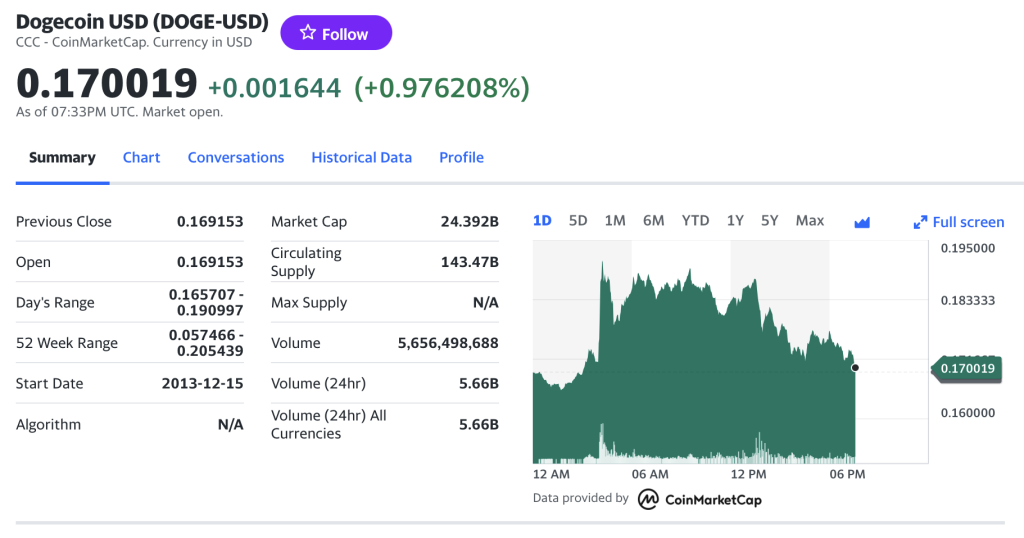
Source: Yahoo! Finance.
Historical data for the Doge Coin market prices
Since its inception in 2013, Dogecoin has experienced notable price fluctuations, driven by a combination of factors including market speculation, community engagement, and broader trends in the digital asset space. Initially launched as a joke currency, Dogecoin’s price remained relatively stable for several years, trading at fractions of a cent. However, its price surged dramatically in early 2021, fueled by social media hype and celebrity endorsements, reaching all-time highs of over 70 cents per coin. This unprecedented rally brought Dogecoin into the spotlight, attracting widespread attention from investors and media outlets. Despite subsequent price corrections, Dogecoin has maintained a prominent position in the cryptocurrency market, with its price influenced by various factors including Elon Musk’s tweets, meme culture, and broader market sentiment. Overall, the historical price evolution of Dogecoin exemplifies the volatile and dynamic nature of the cryptocurrency market, highlighting the interplay between community enthusiasm, market speculation, and broader industry trends.
Figure 3 below represents the evolution of the price of Doge Coin in US dollar over the period November 2018 – December 2022. The price corresponds to the “closing” price (observed at 10:00 PM CET at the end of the month).
Figure 3. Evolution of the Doge Coin price
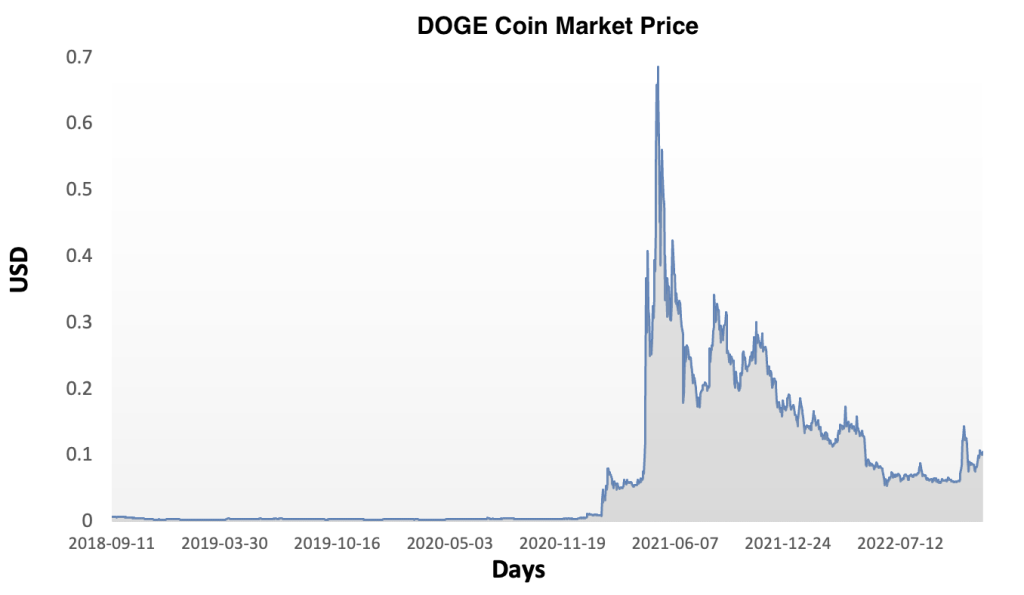
Source: Yahoo! Finance.
R program
The R program below written by Shengyu ZHENG allows you to download the data from Yahoo! Finance website and to compute summary statistics and risk measures about the Doge Coin.

Data file
The R program that you can download above allows you to download the data for the Doge Coin from the Yahoo! Finance website. The database starts on October, 2018.
Table 1 below represents the top of the data file for the Doge Coin downloaded from the Yahoo! Finance website with the R program.
Table 1. Top of the data file for the DOGE Coin
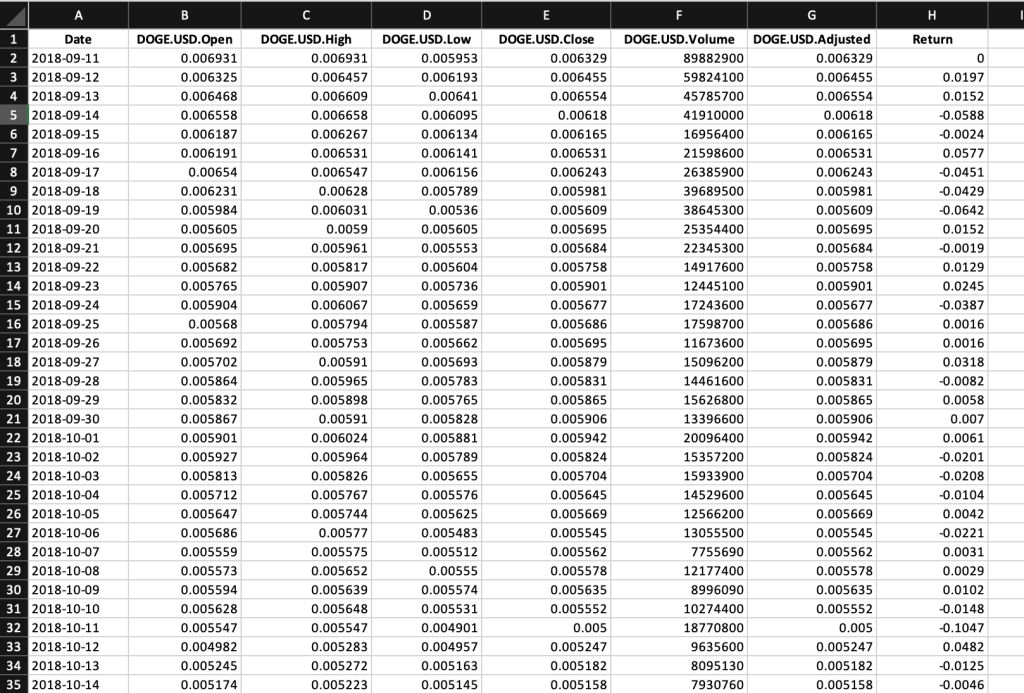
Source: computation by the author (data: Yahoo! Finance website).
Python code
You can download the Python code used to download the data from Yahoo! Finance.

Python script to download Doge historical data and save it to an Excel sheet::
import yfinance as yf
import pandas as pd
# Define the ticker symbol for Doge Coin
doge_ticker = “DOGE-USD”
# Define the date range for historical data
start_date = “2020-01-01”
end_date = “2022-01-01”
# Download historical data using yfinance
doge_data = yf.download(doge_ticker, start=start_date, end=end_date)
# Create a Pandas DataFrame from the downloaded data
doge_df = pd.DataFrame(doge_data)
# Define the Excel file path
excel_file_path = “DOGE_historical_data.xlsx”
# Save the data to an Excel sheet
doge_df.to_excel(excel_file_path, sheet_name=”DOGE_historical_data”)
print(f”Data saved to {excel_file_path}”)
# Make sure you have the required libraries installed and adjust the “start_date” and “end_date” variables to the desired date range for the historical data you want to download
Evolution of the Doge Coin
Figure 4 below gives the evolution of the Doge Coin on a daily basis.
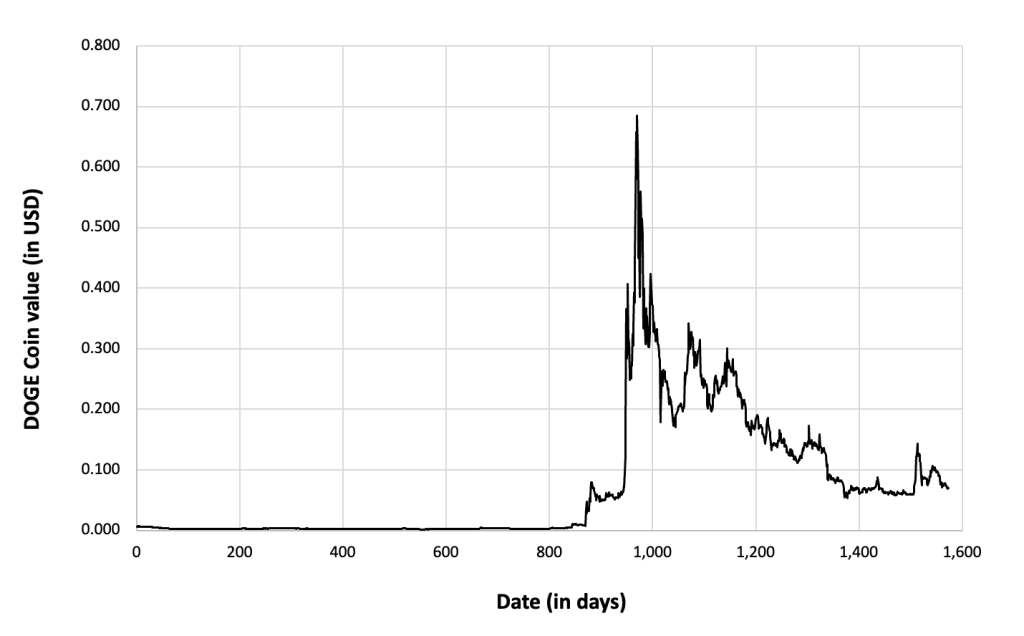
Figure 4. Evolution of the DOGE Coin Figure 5 below gives the evolution of the Doge Coin returns from November, 2018 to December 31, 2022 on a daily basis.
Figure 5. Evolution of the Doge Coin returns.
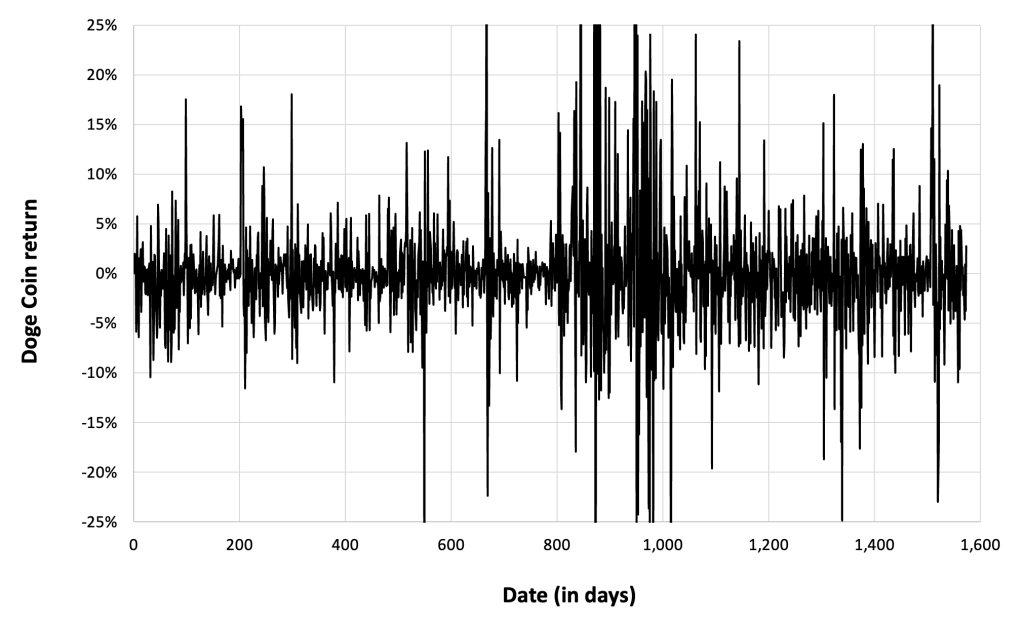
Source: computation by the author (data: Yahoo! Finance website).
Summary statistics for the Doge Coin
The R program that you can download above also allows you to compute summary statistics about the returns of the Doge Coin. Table 2 below presents the following summary statistics estimated for the Doge Coin:
- The mean
- The standard deviation (the squared root of the variance)
- The skewness
- The kurtosis.
The mean, the standard deviation / variance, the skewness, and the kurtosis refer to the first, second, third and fourth moments of statistical distribution of returns respectively.
Table 2. Summary statistics for Doge Coin.
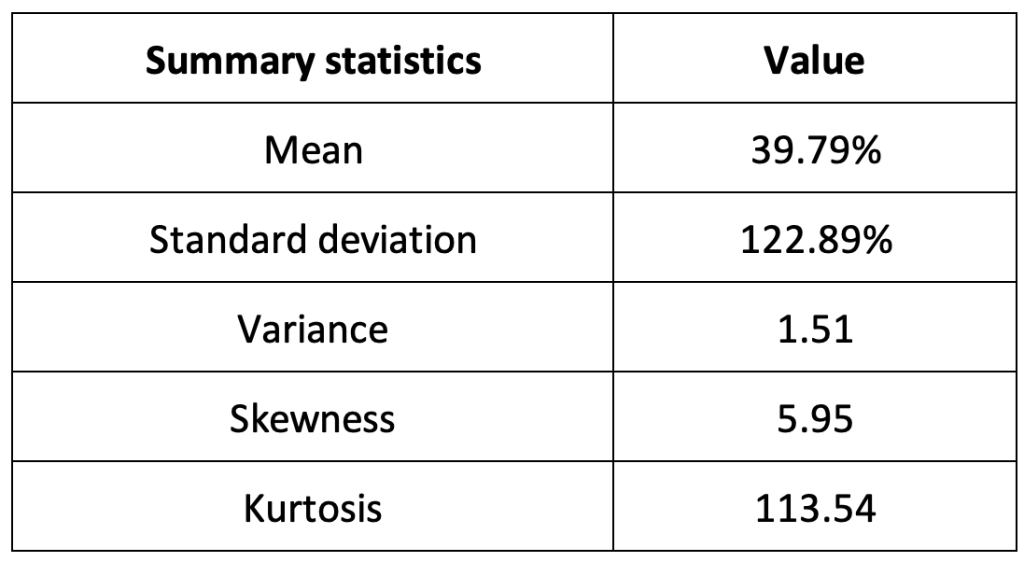
Source: computation by the author (data: Yahoo! Finance website).
Statistical distribution of the Doge Coin returns
Figure 6 represents the historical distribution of the Doge Coin daily returns for the period from November, 2018 to December 31, 2022.Figure 6. Historical Doge Coin distribution of the returns.
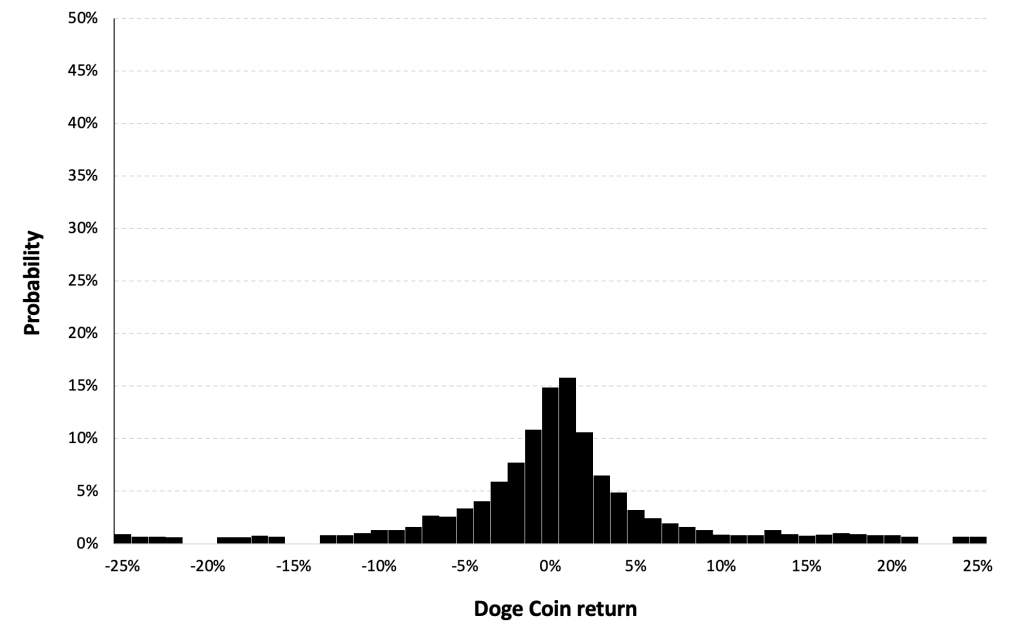
Source: computation by the author (data: Yahoo! Finance website).
Gaussian distribution
The Gaussian distribution (also called the normal distribution) is a parametric distribution with two parameters: the mean and the standard deviation of returns. We estimated these two parameters over the period from October, 2018 to December 31, 2022. Figure 7 below represents the Gaussian distribution of the Ethereum daily returns with parameters estimated over the period from October, 2018 to December, 2022.Figure 9. Gaussian distribution of the Doge Coin returns.
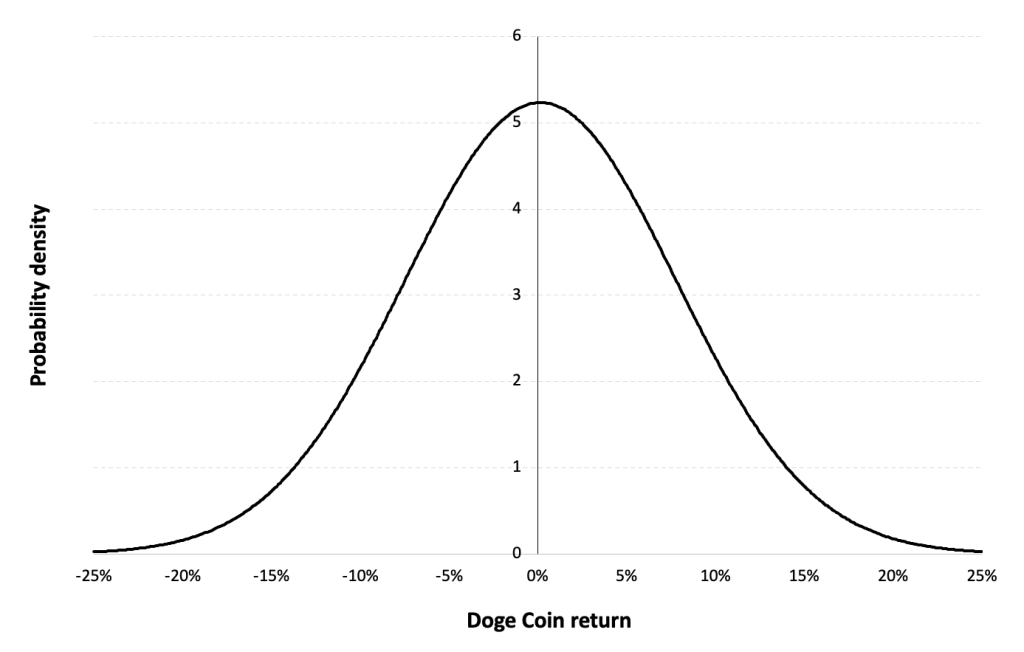
Source: computation by the author (data: Yahoo! Finance website).
Risk measures of the Doge Coin returns
The R program that you can download above also allows you to compute risk measures about the returns of the Doge Coin.
Table 3 below presents the following risk measures estimated for the Doge Coin:
- The long-term volatility (the unconditional standard deviation estimated over the entire period)
- The short-term volatility (the standard deviation estimated over the last three months)
- The Value at Risk (VaR) for the left tail (the 5% quantile of the historical distribution)
- The Value at Risk (VaR) for the right tail (the 95% quantile of the historical distribution)
- The Expected Shortfall (ES) for the left tail (the average loss over the 5% quantile of the historical distribution)
- The Expected Shortfall (ES) for the right tail (the average loss over the 95% quantile of the historical distribution)
- The Stress Value (SV) for the left tail (the 1% quantile of the tail distribution estimated with a Generalized Pareto distribution)
- The Stress Value (SV) for the right tail (the 99% quantile of the tail distribution estimated with a Generalized Pareto distribution)
Table 3. Risk measures for the Doge Coin.
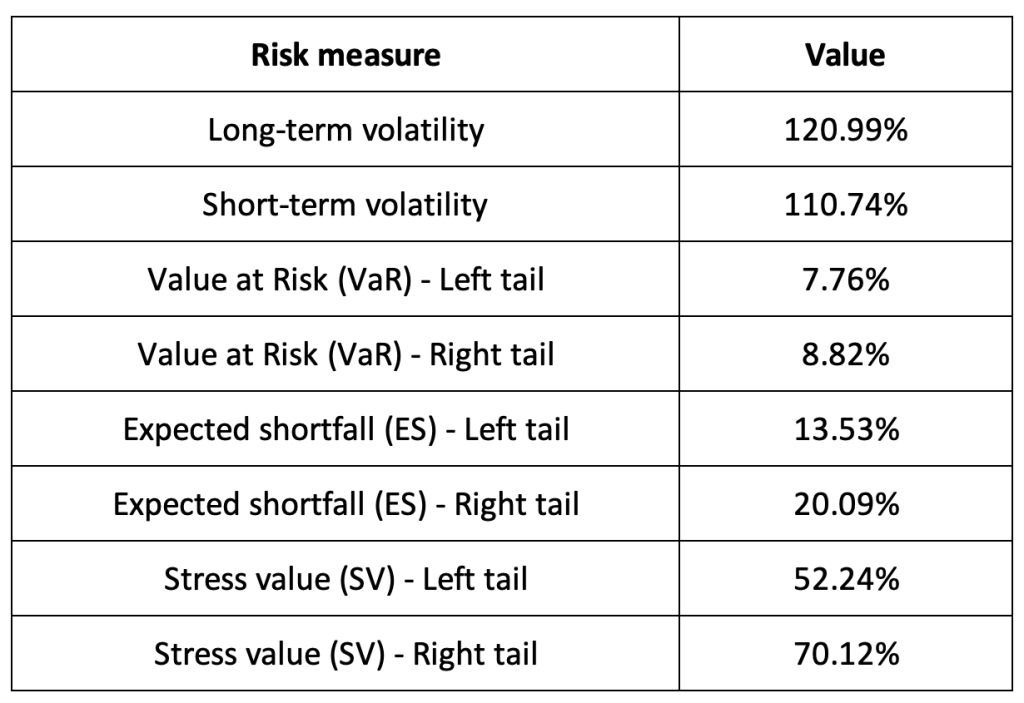
Source: computation by the author (data: Yahoo! Finance website).
The volatility is a global measure of risk as it considers all the returns. The Value at Risk (VaR), Expected Shortfall (ES) and Stress Value (SV) are local measures of risk as they focus on the tails of the distribution. The study of the left tail is relevant for an investor holding a long position in the XRP while the study of the right tail is relevant for an investor holding a short position in the Doge Coin.
Why should I be interested in this post?
This blog offers an engaging exploration into a cryptocurrency that transcends traditional finance, appealing to a wide audience due to its cultural relevance, investment potential, and vibrant community. From its origins as a meme coin to its remarkable price movements, understanding Dogecoin’s dynamics provides valuable insights into both the cryptocurrency market and internet culture. Delving into its technological underpinnings, community engagement, and market trends offers a concise yet comprehensive overview of Dogecoin’s significance in the evolving landscape of digital currencies.
Related posts on the SimTrade blog
About cryptocurrencies
▶ Snehasish CHINARA Bitcoin: the mother of all cryptocurrencies
▶ Snehasish CHINARA How to get crypto data
▶ Alexandre VERLET Cryptocurrencies
▶ Youssef EL QAMCAOUI Decentralised Financing
▶ Hugo MEYER The regulation of cryptocurrencies: what are we talking about?
About statistics
▶ Shengyu ZHENG Moments de la distribution
▶ Shengyu ZHENG Mesures de risques
▶ Jayati WALIA Returns
Useful resources
Academic research about risk
Longin F. (2000) From VaR to stress testing: the extreme value approach Journal of Banking and Finance, N°24, pp 1097-1130.
Longin F. (2016) Extreme events in finance: a handbook of extreme value theory and its applications Wiley Editions.
Data
Yahoo! Finance Historical data for Doge Coin
CoinMarketCap Historical data for Doge Coin
